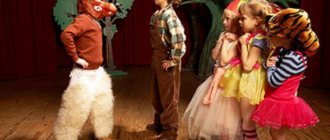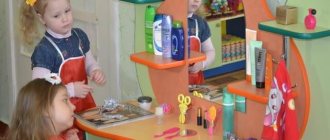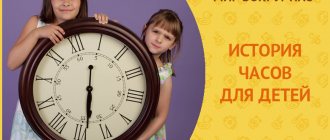The middle group of kindergarten is intended for children of four years of age. During this period, children develop the ability to establish simple connections between surrounding objects. Children are interested in the actions of adults, imitate them in everything, and try to overcome small difficulties on their own. Speech is significantly enriched through communication with adults and peers. The middle group gives children the skills of correct and organized behavior in the garden, on the street, at home. Forms the simplest ideas about what is bad or good. Creativity and ear for music will also improve.
Physical education in the middle group
In physical education lessons, children learn to run easily and rhythmically, and to maintain correct posture when running.
Kids try to move freely along the wall bars, changing the pace and direction, jumping from a small height onto a soft surface, long jumping, high jumping, learning to jump over a long and short rope. The teacher gives the first throwing skills with both left and right hands. Children not only throw the ball in all sorts of directions, but also learn to catch it and hit it while standing still and while walking. Children also acquire the skill of lining up in a line according to their height and performing turns in the ranks. In physical education lessons in the middle group, in a playful way, children master exercises from sports games such as badminton, football, and towns. At this age, they can independently organize familiar games with given plots.
In motor activity, creativity develops, the ability to change and complicate exercises and games is formed, with the addition of imitation elements that demonstrate the plasticity and grace of movements.
“Childhood” program age characteristics of children from 4 to 5 years old
Program "CHILDHOOD"
Age characteristics of children from 4 to 5 years old
The physical capabilities of children have increased: their movements have become much more confident and varied. Preschoolers have an urgent need to move. If active motor activity is limited, they quickly become overexcited, become disobedient, and capricious.
Children actively demonstrate a desire to communicate with peers. Their verbal contacts become more effective and efficient. Preschoolers 4-5 years old willingly cooperate with adults in practical matters, but at the same time they are increasingly striving for cognitive, intellectual communication. The age of “why” is manifested in numerous questions from children to the teacher: “Why?”, “Why?”, “For what?” The child's developing thinking, the ability to establish the simplest connections and relationships between objects awaken a wide interest in the world around him.
The child is able to analyze objects simultaneously according to 2-3 characteristics: color and shape, color, shape and material, etc.
Children aged 4-5 years clearly show interest in the game. The game becomes more complex in content, number of roles and role-playing dialogues. A notable feature of children is their imagination; they often confuse fiction and reality. Children of this age are experiencing an awakening interest in the rules of behavior.
Children are actively developing and maturing their emotional sphere: feelings become deeper and more stable; the previous joyful feeling from communicating with others gradually develops into a more complex feeling of sympathy and affection. In the fifth year of life, awareness of one’s gender begins. Children note the external differences between boys and girls.
Children's vocabulary increases to 2000 words or more. In conversation, the child begins to use complex phrases and sentences.
Planned intermediate results of children's mastery of the basic general education program of preschool education.
Middle group (5 years)
By the age of five, with successful completion of the Program, the following level of development of the child’s integrative qualities is achieved:
Physically developed, mastered basic cultural and hygienic skills.
Anthropometric parameters (height, weight) are normal. Physical capabilities have increased significantly: movements have become much more confident and varied. Experiences an urgent need to move and is highly excitable. If active motor activity is limited, he becomes overexcited, disobedient, and capricious. Emotionally charged activities become not only a means of physical development, but also a way of psychological relief for children of middle preschool age. Performs age-appropriate hygienic procedures and follows basic rules of a healthy lifestyle. Talks about the sequence and necessity of performing cultural and hygienic skills - dressing for a walk, eating and using cutlery, using personal hygiene items. He is independent in self-care, sets goals himself, sees the need to perform certain actions.
Curious, active.
He is highly active and inquisitive. Asks a lot of searching questions: “Why?”, “Why?”, “For what?”. Strives to establish connections and dependencies in nature and the social world. Masters the basic methods of cognition, has some experience in activities and a stock of ideas about the environment, and with the help of the teacher is actively involved in experimentation activities. In the process of joint research activities, actively learns and names the properties and qualities of objects, features of natural objects, and research activities. Unites items and objects into specific categories indicating characteristic features.
Emotionally responsive
. Responds to the emotions of loved ones and friends. To attract and maintain the attention of a peer, he uses means of intonational speech expressiveness - voice strength, intonation, rhythm and tempo of speech. He reads poetry expressively, retells short stories, conveying his attitude towards the characters. Uses words of participation, emotional sympathy, and compassion in speech to maintain cooperation and establish relationships with peers and adults. Using figurative language, he conveys the emotional states of people and animals. Experiences joy from communicating with animals and plants, both familiar and new to him. Empathizes with fairy tale characters. Reacts emotionally to works of art and the natural world.
Mastered the means of communication and ways of interacting with adults and peers.
Actively demonstrates a desire to communicate with peers. Needs meaningful contacts with peers about toys, joint games, and common affairs. Speech contacts become longer and more active, and the first friendly connections between children are established. At the suggestion of the teacher, he can agree with a peer about playing together, select the necessary toys, and create a play environment. Strives for self-expression in activities, recognition and respect of peers. Willingly cooperates with adults not only in practical matters (joint games, work assignments, caring for animals, plants), but also actively strives for cognitive, intellectual communication with adults - asks many questions of a searching nature. Begins to show respect to elders, calling them by name and patronymic. In a familiar environment, he independently follows the familiar rules of communication with adults, says hello and goodbye, says “thank you” and “please.”
Able to manage one’s behavior and plan one’s actions based on primary value concepts, observing basic generally accepted norms and rules of behavior.
Knows different ways of activity, shows independence, strives for self-expression. Behavior is determined by the demands of adults and primary value ideas about “what is good and what is bad” (for example, you can’t fight, it’s bad to tell lies, you need to share, respect adults, etc.). With the help of an adult, he can outline actions aimed at achieving a specific goal. When reminded by an adult, he tries to adhere to the basic rules of behavior at home and on the street.
Able to solve intellectual and personal tasks (problems) appropriate for age.
Can apply acquired knowledge and methods of activity to solve simple problems set by adults. Friendly in communicating with peers in joint activities. Shows interest in various types of activities and actively participates in them. Masters the skills of experimentation and, with the assistance of an adult, actively uses them to solve intellectual and everyday problems.
Having primary ideas about oneself, family, society, state, world and nature.
Self-image.
Knows his first name (full and short), last name, age, gender. He is aware of some of his skills (“I can draw”), knowledge (“I know what this fairy tale is about”), and what he has learned (“to build a house”). Strives to learn from an adult some information about his body (what arms, legs, eyes, eyelashes, etc. are needed for).
Ideas about family
. Knows the composition of his family, talks about the activities of his family members, family events, holidays, favorite toys, pets.
Ideas about society (the nearest society),
its cultural values. Talks with the teacher about the professions of kindergarten workers: assistant teacher, cook, nurse, teacher, laundress.
Ideas about the state.
Knows the name of the country and city in which he lives, orients himself well in his immediate surroundings.
Having mastered the universal prerequisites for educational activities.
Able to work according to a model. Knows how to listen to an adult and carry out his tasks, answer when asked.
Having mastered the necessary skills and abilities.
The child has developed the skills and abilities necessary to carry out various types of children's activities.
Get text
Mental education in the middle group
Thanks to their expanding vocabulary and excellent memory, children remember a huge number of names of modes of transport, objects that make a person’s life easier, or create comfort. In addition, the middle group of kindergarten gives children the ability to determine the color, shape, size, weight, and material from which an object is made. Based on these properties, children try to verbally describe surrounding objects. With these skills, toddlers are able to classify and generalize objects using concepts of hardness, brittleness, shine, ringing, and surface temperature.
In the middle group, children are taught thrift in relation to objects and toys. Now they understand that any thing is the result of the work of many people. Along the way, the kids are given the names of some professions in agriculture, construction, communications, and military specialties. The basics of traffic rules are studied, for example, how to behave at a traffic light. Children also need to know the names of relatives and home address, the name of the city in which they live, the country, the capital.
What does a teacher teach four-year-old children?
Pupils of the middle group develop independence skills. Classes are conducted to teach them different ways of doing things. Self-service skills are gradually developed in children. Particular attention is paid to teaching game actions. All tasks can be found in the program by finding the “Middle Group” section there. Games are presented in blocks. It is indicated which of them need to be planned during physical education classes, which ones - during a walk and during free activity. Manual labor also occupies an important place in the middle group of kindergarten. During its organization, the teacher solves many educational, developmental and educational tasks. Such activities contribute to the formation of a friendly atmosphere in the team. Manual labor in the middle group is attractive to children because it provides an opportunity to show individuality and creativity. Speech development classes are organized according to a program appropriate for a given age group. Teachers also formulate children’s ideas about a healthy lifestyle. The program for a kindergarten involves planning the activities of the teacher in such a way that it contributes to the full development of each pupil. This is possible due to compliance with the regime, which is compiled for the middle group, taking into account the characteristics of its pupils.
Speech development in the middle group
The middle group of kindergarten gives children their first knowledge of sounds, syllables, and sentences. Children learn to explain game rules, give reasons for the statements and answers of their peers. By using complex sentences of various types, direct and indirect speech, and using a model, they can tell short stories about events that took place in their lives. Independently, without significant omissions or deviations, children retell the plot of literary works and compose the ending of fairy tales based on the pictures that the teacher shows them.
Should I send my child to kindergarten?
In the modern world, mothers are in a hurry to return to work early from maternity leave. If there are no adults in the family who could look after the child, then kindergarten for children becomes a necessity.
Moms and dads can be divided into two camps. For example, mom is sure that kindergarten brings only negativity, and dad is convinced that kindergarten is necessary for the socialization and preparation of the child for school. Let's figure out whose position is correct and consider all the pros and cons of visiting a kindergarten.
Mathematics in the middle group
In mathematics classes in the middle group, children study the components of a small group of objects, determine the differences and similarities in them, making comparisons in pairs or using counting. The teacher gives the concept that an individual object is always smaller than the group in which this object is included. Children learn to count to ten, and they master the ability to compare groups and determine which of them has more objects, or fewer, or are equal. Kids line up objects in ascending and descending order not only of size, but also of width, length, and height. At the same time, they can correctly answer how many items there are in total and which item is counted.
Mathematics in the middle group expands the concept of geometric shapes, such as circle, oval, triangle, quadrangle. The teacher explains the sequence of parts of the day and gives the concept of the day of the week.
Psychologist's advice
- If you have finally decided to send your child to kindergarten, then be consistent and persistent. This way the child will understand that there is no point in manipulating you and it is better to reconcile with the kindergarten.
- Warn teachers if your child has any chronic diseases or developmental disabilities or is allergic to anything.
- If your baby refuses to eat, then you need to warn the teachers so that they do not force-feed him. After some time, the child himself will begin to eat with other children.
- Especially during the adaptation period, parents should be supportive of their child and scold him as little as possible, because the baby is already under stress.
- Even before going to kindergarten, take your little one to playgrounds as often as possible, introduce him to a new team and make acquaintances.
- The opinion of psychologists agrees that in the first days there is no need to leave a child in kindergarten for more than 2-3 hours, if possible.
- To make it easier to get used to new conditions, you can bring your own toys to the kindergarten. Familiar objects will give your baby confidence. It is advisable for the child to leave the toy in the kindergarten when going home. So the next day he will go to kindergarten with great pleasure to play with her again.
- When parting with your baby, be sure to warn him that you will be back very soon. Tell him often that you love him very much.
- Create a calm, conflict-free atmosphere in your home.
Think back to your time in kindergarten. What memories do you have? If they are negative (for example, you didn’t like the food in the garden or were afraid of an evil teacher), then do not pass on your negative experience to your child. It is important that you yourself are prepared for the garden. Meet the teachers and look around the group. For a child, it is necessary that his significant adult be calm and confident.
The child reads all your states. And if you feel anxious before kindergarten, then how can your child be calm? It's like flying on a plane where the pilot is constantly nervously shouting into the microphone that we're all going to crash,
– Svetlana Ilyukhina,
practicing psychologist.
From a scientific point of view, visiting kindergarten after three years will benefit your baby. The main thing here is not to make a mistake when choosing a preschool institution. After all, it is in kindergarten that a child begins to master the art of communication, which determines human life in the future.
Visual activities in the middle group
In fine arts lessons, the middle group of kindergarten gives children knowledge about the means of expression in various types of art, such as form, coloring, color and composition, and stimulates interest in painting, book graphics, and folk decorative art.
Drawing in the middle group
By drawing, kids learn to create images based on ideas or nature; They try to create stories on given topics from life or natural phenomena. Concepts are also given about shades that kids actively use when creating images and patterns based on folk arts and crafts.
Modeling and appliqué in the middle group
Modeling and applique becomes a little more complicated. Now kids create not just individual objects, but entire productions and compositions. Using previously acquired skills, they try to convey the proportions and movements of the figures.
By constructing in a team, children learn to interact with peers to find new constructive solutions and plan construction stages.
Musical education in the middle group
Music lessons in the middle group of kindergarten give children the first knowledge about the genres of musical works and the sound of musical instruments. Kids learn to distinguish works by intro or melody. The range of low and high sounds expands. By performing songs with musical accompaniment, children master smooth and easy singing.
Based on the character and dynamics of music, children learn to move rhythmically, changing the direction and smoothness of movements. Skills are given for independently staging songs and round dances, for performing actions without imitating each other.
How do you know if your child is ready for kindergarten?
To enroll a child in a nursery group, it is advisable that the child has the following skills:
- could fall asleep on his own without nipples and rocking in his arms;
- was taught to use a cup;
- asked to go to the potty and went without diapers while awake, and also reported if he could not get to the potty;
- knew how to eat on his own.
For admission to the junior group, the following points are added to all of the above:
- showed at least some interest in classes;
- had experience communicating with children;
- explained himself minimally;
- dressed himself.
But even if a child has all these skills, he is not ready to attend kindergarten if he has not had time to enjoy his parents. This can be understood by the baby's behavior. If he plays with children, but constantly looks back at you, controls your presence, then you need to postpone the idea of attending kindergarten and certainly not count on a gentle adaptation.
Take a closer look at your child’s behavior on playgrounds. If he shows interest in his peers (not in older children, but in his peers), and is actively involved in playing together, then in kindergarten he will get along well with other children,
– Svetlana Ilyukhina,
practicing psychologist.
Physical development
At this age, the child is physically active. He is able to run, while coordinating and coordinating the work of his legs and arms, jump on two legs, play with a ball and throw it a short distance with his right and left hands, climb the Swedish stairs, climb over various objects, line up in pairs, line up in a circle or line. During this period, some children are already successfully mastering a two-wheeled bicycle.
A number of children show higher data, they develop somewhat faster than their peers, master skills better and faster and absorb information. This does not mean that children who meet the requirements of the middle group program are lagging behind in development and learning. On the contrary, it is the more developed children who stand out from the average level. This is normal and natural, all children are different, and this is not a reason for parents to panic and compare their son or daughter with more developed peers. If the baby meets the level of knowledge of his age, then everything is normal. Small deviations with a minus sign may also occur. Only a strong discrepancy between the child’s age and the level of his physical and mental development should cause alarm.
Development of coherent and clear speech
- Correctly and clearly articulates the sounds of his native language. There may be some difficulties in pronouncing some complex sounds, such as hissing. Also, some children do not pronounce “l” and “r” clearly.
- Knowledge of singular and plural numbers. The ability to generalize objects into groups and voice their common name: dolls and cubes - toys, spoons and mugs - dishes, table and chair - furniture and so on.
- Compose competent sentences and small coherent texts.
- Make retellings, as well as descriptions of pictures and objects.
- Answer the teacher’s questions about the work you read.
- Know short children's poems by heart.
Getting to know the world around you
- Knows the shapes, sizes and materials of objects.
- Knows the basic objects that surround him in everyday life: furniture, dishes, clothes, shoes, toys, food, plants, vehicles.
- Knows the body parts of humans and animals.
- Knows the locality where he lives.
- Possesses basic skills of traffic rules: pedestrian crossing, green and red traffic lights.






